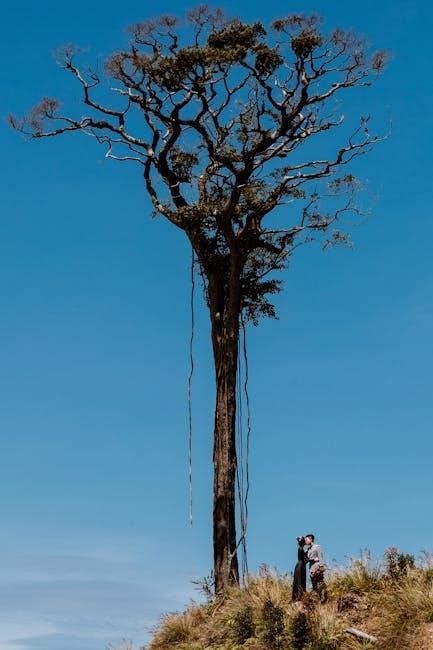The Great Kapok Tree: An Exploration
Lynne Cherry’s “The Great Kapok Tree” is a captivating tale set within the lush Amazon rainforest. This exploration delves into the book’s themes, characters, and message. It highlights the vital role the Kapok tree plays in the ecosystem. The story emphasizes environmental conservation through its narrative and illustrations, prompting readers to appreciate the rainforest’s interdependence.

Overview of “The Great Kapok Tree” by Lynne Cherry
Lynne Cherry’s “The Great Kapok Tree” unfolds as a vibrant narrative set deep within the Amazon rainforest, presenting a compelling case for environmental conservation. The story centers on a man tasked with cutting down a magnificent Kapok tree, but as he rests, the rainforest’s inhabitants, from squawking birds to howling monkeys, whisper their pleas, revealing the tree’s critical role in their survival. The book beautifully illustrates the interdependence of life within the rainforest ecosystem, showcasing the unique animals and plants that rely on the Kapok tree.
Cherry’s work serves as an enchanting introduction to ecological awareness for young readers. The narrative cleverly intertwines the natural world’s beauty with an urgent call to protect it. The man’s internal conflict and eventual change of heart underscore the book’s central message: every creature, big or small, plays a vital part in maintaining the rainforest’s delicate balance. The visually stunning illustrations further enhance the story, making “The Great Kapok Tree” a powerful and educational read.
Thematic Focus: Environmental Conservation
“The Great Kapok Tree” by Lynne Cherry serves as a potent allegory for environmental conservation, weaving a narrative that underscores the critical importance of preserving rainforest ecosystems. The story vividly portrays the interconnectedness of all living things within the Amazon, highlighting how the destruction of a single tree, the Kapok, can have far-reaching consequences. The animals’ desperate pleas to the sleeping man resonate with the urgent need to protect biodiversity and prevent deforestation.
The book emphasizes the rainforest’s role as a vital resource for the planet, providing clean air, regulating climate, and housing countless species. Through the man’s initial intention to cut down the tree and his subsequent change of heart, Cherry explores the conflict between human needs and environmental responsibility. The story advocates for a more sustainable approach, urging readers to consider the long-term impact of their actions on the natural world. “The Great Kapok Tree” effectively conveys the message that protecting our environment is not just a noble cause, but a necessity for our own survival.
The Setting: The Amazon Rainforest
The Amazon rainforest, a sprawling and biodiverse ecosystem, serves as the vibrant backdrop for Lynne Cherry’s “The Great Kapok Tree.” This setting is not merely a location but an integral character in the story, influencing the plot and shaping the narrative’s thematic focus on environmental conservation. The rainforest is depicted as a lush, teeming environment, alive with the sounds and sights of countless creatures, all interconnected and dependent on each other for survival.
Cherry’s vivid descriptions transport readers to the heart of the Amazon, allowing them to experience its steamy humidity, dense foliage, and the cacophony of its inhabitants. The Kapok tree itself is a symbol of the rainforest’s grandeur and importance, towering above the canopy and providing shelter and sustenance for a multitude of species. The threat to the Kapok tree represents the broader threat to the entire rainforest ecosystem. The setting emphasizes the fragility of this environment and the devastating consequences of deforestation. The Amazon’s rich biodiversity and ecological significance amplify the book’s message about the need to protect our planet’s natural resources.
Characters: The Man and the Rainforest Creatures
In “The Great Kapok Tree,” Lynne Cherry presents a compelling cast of characters, primarily focusing on the man and the diverse rainforest creatures. The man, initially portrayed as a potential destroyer, embodies humanity’s capacity to harm the environment. He enters the rainforest with the intent to chop down the Kapok tree, representing the destructive forces of deforestation and exploitation of natural resources. His character undergoes a transformation as he encounters the pleas of the rainforest inhabitants.
In stark contrast, the rainforest creatures represent the interconnectedness of the ecosystem. They are the embodiment of the rainforest’s inherent value and vulnerability. Each animal, from the jaguar to the tiny tree frog, has a unique voice and a compelling reason for preserving the Kapok tree. Their collective plea highlights the interdependence of all living things within the rainforest. They showcase the devastating impact the man’s actions would have on their home and their lives. The creatures serve as a powerful reminder of the importance of respecting and protecting the natural world. Their vulnerability underscores the ethical responsibility humans have towards the environment.

Plot Summary: The Man’s Hesitation
The plot of “The Great Kapok Tree” centers around a man’s internal conflict as he prepares to cut down a Kapok tree in the Amazon rainforest. Initially, he arrives with a clear purpose: to fell the tree. He begins his task with vigor, swinging his ax and making initial cuts into the tree’s trunk. However, the oppressive heat and the sounds of the rainforest soon lull him into a deep sleep at the base of the Kapok tree.
During his slumber, the rainforest creatures approach him one by one, whispering their pleas into his ear. Each animal explains how their lives are intertwined with the Kapok tree and how its destruction would devastate their home and their existence. As the animals share their stories, the man begins to experience a shift in his perspective. He hears their desperate appeals and witnesses the interconnectedness of the rainforest ecosystem. When he awakens, he is confronted with the choice of continuing his destructive path or heeding the warnings of the rainforest. He hesitates, contemplating the impact of his actions, ultimately dropping his ax and walking away, signifying a change of heart and a recognition of the value of the rainforest.
The Animals’ Plea and its Impact
In Lynne Cherry’s “The Great Kapok Tree,” the animals’ plea is a pivotal moment that drives the narrative and underscores the book’s central theme of environmental conservation. As the man sleeps, exhausted from attempting to cut down the Kapok tree, the various creatures of the rainforest approach him. Each animal, from the smallest insects to the largest mammals, whispers their concerns and explains their reliance on the tree.
Their pleas highlight the interconnectedness of the rainforest ecosystem, demonstrating how the Kapok tree serves as a vital habitat and resource for numerous species. The animals’ voices collectively convey a sense of urgency, emphasizing the potential devastation that would result from the tree’s destruction. The impact of their words is profound, as they awaken the man’s conscience and prompt him to reconsider his actions. The animals’ plea serves as a powerful reminder of the importance of protecting the environment and recognizing the value of every living creature within it. Their collective voice ultimately sways the man’s decision, leading him to abandon his destructive intent and leave the Kapok tree standing.
Illustrations and their Significance
The illustrations in Lynne Cherry’s “The Great Kapok Tree” are not merely decorative; they are integral to the story’s message and emotional impact. Cherry’s artwork vividly portrays the lushness and biodiversity of the Amazon rainforest, immersing readers in its vibrant world. The detailed depictions of the animals, from their expressive eyes to their intricate patterns, evoke empathy and a sense of connection.
The illustrations also serve to highlight the interconnectedness of the ecosystem. They show how the Kapok tree is a central hub of life, providing shelter, food, and support for a diverse range of creatures; The use of color is particularly significant, with bright hues representing the beauty and vitality of the rainforest, and darker shades hinting at the potential consequences of its destruction. Furthermore, the illustrations enhance the emotional impact of the animals’ pleas, conveying their vulnerability and desperation. Through her art, Cherry effectively communicates the importance of environmental conservation and the need to protect the rainforest’s precious resources. The illustrations amplify the narrative, making the story more accessible and engaging for readers of all ages.
Educational Value: Teaching Interdependence
“The Great Kapok Tree” offers significant educational value by effectively teaching the concept of interdependence within ecosystems. The story illustrates how the Kapok tree serves as a central component, supporting a vast array of plant and animal life in the Amazon rainforest. Through the animals’ pleas to the man, readers learn that each creature, no matter how small, plays a vital role in the rainforest’s delicate balance.
The book encourages critical thinking about the consequences of deforestation and habitat destruction, prompting discussions about responsible environmental stewardship. Furthermore, the narrative promotes empathy by allowing readers to connect with the animals and understand their reliance on the Kapok tree for survival. This fosters a sense of responsibility towards protecting biodiversity and natural resources. “The Great Kapok Tree” serves as a valuable tool for educators to introduce ecological concepts, encourage environmental awareness, and inspire students to become advocates for conservation. It underscores the importance of understanding and respecting the intricate web of life that sustains our planet.
The Kapok Tree’s Role in the Ecosystem

The Kapok tree, as depicted in Lynne Cherry’s book, plays a pivotal role in the Amazon rainforest ecosystem. Rising above the canopy, it provides shelter, sustenance, and a habitat for countless creatures. Its massive branches offer nesting sites for birds, monkeys, and other animals, while its flowers provide nectar for insects and hummingbirds. The tree’s large seed pods burst open, releasing fluffy fibers that are used by birds for nesting material and dispersed by the wind to propagate new trees.
The Kapok tree’s presence influences the surrounding environment, contributing to soil stability and water regulation. Its extensive root system prevents erosion, and its leaves provide shade, maintaining moisture levels in the understory. Furthermore, the tree’s decomposition enriches the soil, supporting the growth of other plants. By serving as a keystone species, the Kapok tree supports the biodiversity and health of the rainforest, highlighting its irreplaceable value within the intricate web of life. Its removal would trigger a cascade of negative consequences, impacting numerous species and disrupting the ecosystem’s delicate equilibrium.
Lynne Cherry’s Inspiration and Message
Lynne Cherry’s inspiration for “The Great Kapok Tree” stems from her deep concern for the world’s rainforests and their rapidly diminishing state. Driven by a desire to educate children about the critical importance of these ecosystems, Cherry crafted a story that resonates with both young and old. Her message is clear: rainforests are vital for the planet’s health, and their preservation is essential for the well-being of all living things.
Through the voices of the rainforest animals, Cherry conveys the interconnectedness of life and the devastating consequences of deforestation. She encourages readers to appreciate the intricate relationships within the rainforest and to understand the impact of human actions on the environment. By personifying the animals and giving them a voice, Cherry fosters empathy and inspires a sense of responsibility towards protecting these precious ecosystems. Her ultimate goal is to empower readers to become environmental stewards and advocates for rainforest conservation, ensuring a sustainable future for generations to come. The book serves as a powerful reminder of our shared responsibility to protect the planet’s biodiversity.
Classroom Activities and Lesson Plans

“The Great Kapok Tree” provides a rich foundation for diverse classroom activities and lesson plans, promoting environmental awareness and critical thinking. Students can explore the rainforest ecosystem through research projects, presentations, and interactive simulations. Creative writing exercises can encourage students to write from the perspective of the rainforest animals, expressing their concerns about deforestation.
Art projects, such as creating rainforest dioramas or illustrating scenes from the book, can enhance visual learning and engagement. Debates and discussions can explore the ethical dilemmas surrounding deforestation and sustainable development. Students can analyze the characters’ actions and motivations, considering the impact of their choices on the environment. Furthermore, comparative studies with other environmental stories, like “The Lorax,” can deepen understanding of conservation issues. Teachers can also incorporate mapping activities to locate rainforests worldwide and discuss the importance of biodiversity hotspots. These activities cultivate a sense of responsibility and inspire students to become advocates for environmental protection, fostering a deeper understanding of the interconnectedness of life.
Availability of “The Great Kapok Tree” in PDF Format
For educators and individuals seeking accessible resources, “The Great Kapok Tree” is readily available in PDF format across various online platforms. This digital availability facilitates easy integration into lesson plans and independent reading activities. Several websites offer free downloads of the complete book, allowing students and teachers to access the story without cost barriers. These PDF versions often retain the original illustrations and text, preserving the book’s artistic and narrative integrity.
Educational websites, online libraries, and file-sharing platforms are common sources for obtaining the PDF. Additionally, some educators and organizations share scanned copies or adapted versions of the book for educational purposes. However, it’s crucial to ensure that the downloaded PDF is from a reputable source to avoid copyright infringement and maintain the quality of the content. The PDF format enables users to easily print copies for classroom use or personal enjoyment, further enhancing the book’s accessibility and promoting its message of environmental stewardship to a wider audience. Always verify the legality of the source before downloading.